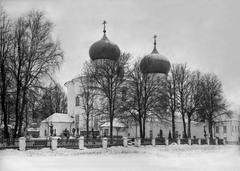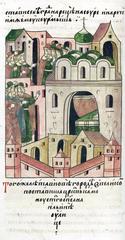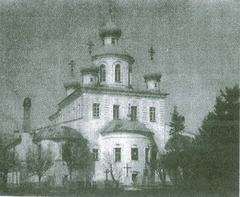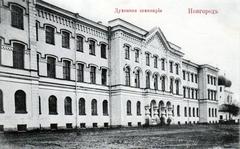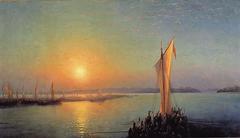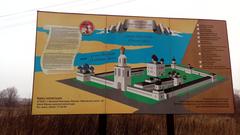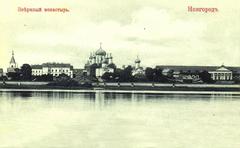Hanseatic Sign Fountain: Guide to Visiting Hours, Tickets, and Veliky Novgorod Historical Sites
Date: 14/06/2025
Introduction
Veliky Novgorod, one of Russia’s oldest and most storied cities, is celebrated as the birthplace of Russian democracy and a vital center of medieval European trade. At the heart of this historical landscape stands the Hanseatic Sign Fountain, an emblematic monument that commemorates the city’s significant role in the Hanseatic League—a powerful association of merchant cities that dominated northern European trade from the late 12th to the 17th century. The fountain, located at Yaroslav’s Court near the Volkhov River, not only honors Novgorod’s past as a thriving trade nexus but also symbolizes the spirit of international cooperation and cultural dialogue that continues to define the city today.
This comprehensive guide explores the history, design, and symbolism of the Hanseatic Sign Fountain, along with practical visitor information, tips for exploring nearby attractions, and advice on how to make the most of your trip to Veliky Novgorod’s historical sites.
Table of Contents
- Introduction
- Historical Background: The Hanseatic League and Veliky Novgorod
- The Hanseatic Sign Fountain
- Cultural Significance and Festivals
- Visitor Information
- Nearby Attractions
- Practical Tips and FAQs
- Conclusion
- Sources and Further Reading
Historical Background: The Hanseatic League and Veliky Novgorod
Veliky Novgorod’s Role in the Hanseatic League
Situated on the Volkhov River, Veliky Novgorod prospered as a key node in the network of Hanseatic cities, linking the Baltic Sea to Russia’s interior. Joining the League in the 13th and 14th centuries, Novgorod became a focal point for commerce, politics, and culture in the medieval world (hanse.org).
Hanseatic Privileges and the Peterhof Kontor
Through treaties established as early as 1191/1192, Hanseatic merchants in Novgorod enjoyed special privileges, including trade protection and reduced tariffs. The Peterhof Kontor—a self-governing merchant quarter—housed warehouses, courts, and trading posts. Here, Middle Low German was commonly spoken, facilitating trade in furs, wax, honey, and European goods (hanse.org).
Economic and Cultural Impact
Novgorod’s prominence as an export center brought prosperity to the city. Goods such as furs and honey were traded for cloth, metals, and grain. The city’s veche, a democratic assembly, reflected the Hanseatic League’s influence on local governance. Architectural and linguistic traces from this era remain visible throughout Novgorod’s urban landscape (audiala.com).
The Hanseatic Sign Fountain: Design, Symbolism, and Artistic Features
Fountain Design and Layout
The Hanseatic Sign Fountain, inaugurated in 2009, is set on the right bank of the Volkhov River at Yaroslav’s Court. Its circular granite base, approximately eight meters in diameter, evokes the shape of a negotiating table—recalling the gatherings of Hanseatic delegates. A thin veil of water flows over the polished granite, creating a reflective surface that mirrors the sky and surrounding architecture (visitnovgorod.ru).
Encircling the fountain are 16 apple trees, symbolizing peace and renewal. The living greenery frames the monument and offers shade, changing with the seasons.
Symbolism and Thematic Elements
The fountain’s design highlights the values of unity and dialogue central to the Hanseatic League. Mosaic coats of arms from 16 member countries, crafted from vibrant colored stone, are embedded in the granite—underscoring the ideals of partnership and equality. The continuous water flow signifies seamless trade and communication between Hanseatic cities (New Hansa official website).
The number 16 reflects the countries represented in the League at the time of the fountain’s inauguration. Today, the New Hansa network includes over 170 cities across 15 European nations, with Veliky Novgorod as the first Russian member.
The Hanseatic Sign: Bronze Sculpture
At the fountain’s center rises the Hanseatic Sign—a bronze sculpture depicting two historic ships: a Hanseatic cogg and a traditional Novgorod boat. Their sails are represented by intertwined bronze trees, symbolizing unity across nations and eras (visitnovgorod.ru).
Artistic Features and Craftsmanship
From its precisely polished granite to the detailed mosaic arms and authentic bronze ships, the fountain showcases expert craftsmanship. A bronze patina lends a sense of historical continuity, while subtle lighting at night transforms the site into a striking riverside landmark.
Cultural Significance and Festivals
Hanseatic Days Festival
The Hanseatic Sign Fountain is the focal point of the annual Hanseatic Days festival. During this event, merchants and artisans recreate the lively atmosphere of a medieval marketplace, offering crafts, foods, and souvenirs. Parades, concerts, and workshops celebrate Novgorod’s Hanseatic legacy and foster international cultural exchange (guidetopetersburg.com).
Legacy in Novgorod’s Urban Landscape
Adjacent landmarks—including Yaroslav’s Court, the Arcade of the Trading Yard, the Novgorod Kremlin, and St. Nicholas Cathedral—offer further insight into the city’s Hanseatic era. These sites are easily included in walking tours and are essential for any history enthusiast (audiala.com, guidetopetersburg.com).
Visitor Information
Visiting Hours and Tickets
- Hanseatic Sign Fountain: Open daily, year-round, with no admission fee. The fountain is accessible 24/7 as an outdoor public monument.
- Nearby Sites: Most museums, including the Novgorod Kremlin, are open 10:00–18:00; ticket prices range from 200–400 RUB. Always confirm times and prices via official sources.
Accessibility and Travel Tips
- Getting There: The fountain is within walking distance of the city center and major attractions. Local buses, taxis, and pedestrian routes are available.
- Wheelchair Accessibility: The site features ramps and smooth pathways; benches and shaded seating are available.
- Facilities: Public restrooms, cafes, and souvenir shops are nearby. Tourist information centers offer maps and multilingual assistance.
- Safety: The area is generally safe, with regular police patrols. Practice standard precautions during festivals or crowded events.
Guided Tours and Special Events
Local agencies offer walking tours focused on Hanseatic heritage, often including the fountain and other historical sites. Special events, such as Hanseatic Days, feature open-air concerts, reenactments, and artisan markets.
Photography and Visuals
Photography is permitted and encouraged—daylight and evening hours highlight the monument’s artistry. Virtual tours and interactive maps are available on official tourism websites for trip planning.
Nearby Attractions
- Yaroslav’s Court: Former princely residence and vibrant public square.
- St. Nicholas Cathedral: One of Russia’s oldest churches, dating to the 12th century.
- Novgorod Kremlin (Detinets): Ancient fortress complex with museums and the iconic St. Sophia Cathedral (Wild Trips).
- Gostiny Dvor Arcade: Historic trade arcade adjacent to the fountain.
Practical Tips and FAQs
General Advice
- Best Visiting Times: Late spring through early autumn (May–September), especially during Hanseatic Days.
- Weather Prep: Dress for the season—warm layers in winter, sun protection in summer.
- Language: Russian is primary; English is increasingly spoken at tourist sites. Translation apps are useful.
- Souvenirs: Local crafts and Hanseatic-themed gifts are available at nearby markets.
FAQ
Q: What are the visiting hours of the Hanseatic Sign Fountain?
A: The fountain is accessible 24/7, all year round.
Q: Is there an entrance fee?
A: No, visiting the fountain is free.
Q: Is the site accessible for wheelchair users?
A: Yes, the area features ramps and paved paths.
Q: Are guided tours available?
A: Yes, especially during Hanseatic Days and through local agencies.
Q: What other attractions are nearby?
A: Yaroslav’s Court, Novgorod Kremlin, St. Nicholas Cathedral, and more.
Q: Can I take photos at the site?
A: Absolutely. The fountain is a popular photography location.
Conclusion
The Hanseatic Sign Fountain stands as a testament to Veliky Novgorod’s illustrious medieval legacy and its enduring role in fostering international trade and cultural collaboration. Whether you are a history enthusiast, a lover of public art, or a traveler seeking unique experiences, a visit to the fountain and its surrounding historical sites offers a comprehensive perspective on the city’s vibrant past and dynamic present.
Plan your trip to coincide with festival periods for an immersive experience, and leverage digital resources like the Audiala app for guided tours and event updates. Embrace the living heritage of the Hanseatic League in Veliky Novgorod—a city where history and modernity intersect in a celebration of shared European identity.
Sources and Further Reading
- The Medieval Hanseatic League: The Origins, n.d., Hanse.org (hanse.org)
- Eternal Flame Memorial - Veliky Novgorod Detinets, n.d., Audiala (audiala.com)
- Major Sightseeings of Veliky Novgorod, n.d., Guide to Petersburg (guidetopetersburg.com)
- Hanseatic League, 2025, Wikipedia (Wikipedia: Hanseatic League)
- Hanseatic Sign Fountain and Veliky Novgorod Tourism, n.d., Visit Novgorod Official Website (visitnovgorod.ru)
- Veliky Novgorod Top 10 Attractions to Visit, n.d., Wild Trips (Wild Trips)
